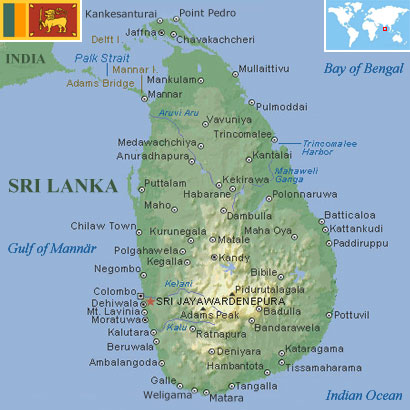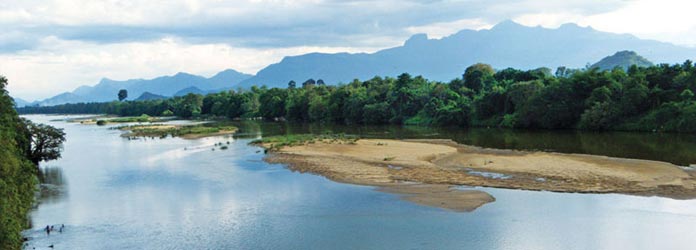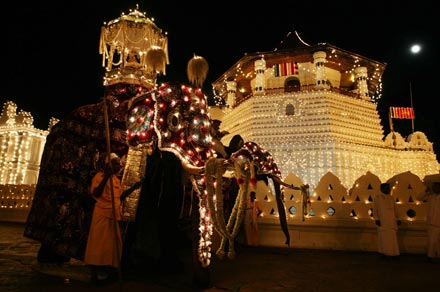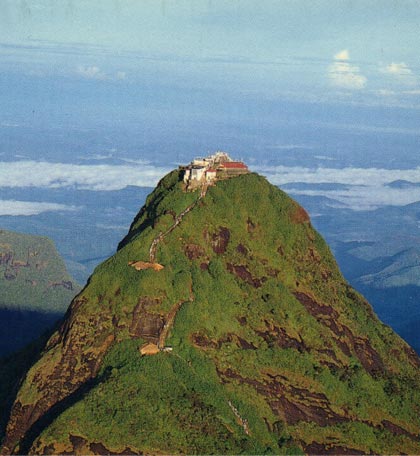Sri Lanka
Country statistics

Land area: 24,996 sq miles (64,740 sq km)
Total area: 25,332 sq miles (65,610 sq km)
Population (2010 est.): 21,513,990 (growth rate: 0.9%); birth rate: 15.8/1000; infant mortality rate: 18.1/1000; life expectancy: 75.3; density per sq miles: 809
Capital City: Sri Jayawardenapura
Monetary unit: Sri Lanka rupee
Languages: Sinhala 74% (official and national), Tamil 18% (national), other 8%; English is commonly used in government and spoken competently by about 10%
Ethnicity/race: Sinhalese 73.8%, Sri Lankan Moors 7.2%, Indian Tamil 4.6%, Sri Lankan Tamil 3.9%, other 0.5%, unspecified 10% (2001)
Religions: Buddhist 70%, Islam 8%, Hindu 7%, Christian 6% (2001)
Country introduction

Located in South Asia, Sri Lanka is an island in the Indian Ocean positioned about 18 miles off the south-east coast of India. It is separated from the Indian subcontinent by the Gulf of Mannar and the Palk Strait.
The country has two geographical regions. The first is a rolling plain which comprises 80% of the land area as well as the entire northern half of the island and continues around the coast to the southern half. The second is the south central region which is hilly and mountainous with two plateaux, the Hatton and Kandy, that rise abruptly from the Ura Basin.
Sri Lanka's highest point is the Pidurutalagala Mountain which is approximately 8,200 ft (2,499 m) above sea level. This mountain is a popular pilgrimage destination and also the only mountain site where people belonging to four different religions assemble for worship. Another mountain believed to be one of the world's most revered mountains is Sri Pada also known as Adam's Peak.
With the exception of the Mahaweli River, numerous rivers originate in the mountains and flow in all directions toward the sea. It is made up of approximately 100 rivers, most of which are small streams (rivulets). The country has 12 major rivers accounting for about 75% of the mean annual river discharge of the country, with those that flow entirely through the Wet Zone (the highlands and the south-western part of the country) carrying about half the total discharge. The Mahaweli Ganga (335 km / 208 miles) and the Aruvi Aru (164 km / 102 miles) are the longest. The Mahaweli river, which originates on the western slopes of the highest areas of the highlands, follows a circuitous route in its upper reaches before it enters the plain to the east of the highlands and then flows toward the north-east coast. Because a part of its catchments is well within the Wet Zone, this river has a larger and less seasonally varied flow than the other Dry Zone rivers and so is a major asset for irrigation in the drier parts of the country.
The culture

Sri Lanka is an island nation with an ancient cultural heritage that dates back over 2,500 years. Ruins of ancient kingdoms and archeological findings provides fascinating insights into a sophisticated ancient society which possessed advanced knowledge of science and technology, town planning and design, and valued the aesthetic beauty of the arts.
A significant event in the history of Sri Lanka was the introduction of Buddhism in the 3rd century BC, which then became an integral part of Sinhalese culture and civilization on the island. The many natural resources of this tropical island along with its natural harbours and strategic location, has attracted many nations in the past. As early as the 5th century, ships from Egypt, Persia, Saudi Arabia, and China docked at the ports to barter their goods for treasures from this island including precious gems, pearls, spices, and scented woods. The Portuguese colonized the island in the 17th century followed by the Dutch and the British changing the course of history. In 1948 Ceylon as it was then called, gained independence from Britain.
Today Sri Lanka is a kaleidoscope of religions and ethnicities with deep rooted traditions influenced by its past history. The majority of the population is Sinhalese but there are significant communities of Tamils, Muslims, Burghers (descendents of the Dutch), and Malays all of whom contribute to make this a colourful and vibrant society.
Sri Lanka's ancient civilization has endowed the island with a legacy of colourful festivals relating to the Buddhist, Hindu, Muslim and Christian religions. The best known internationally is the Kandy Esala Perahera in honour of the Tooth Relic of the Buddha, which is held in Kandy over 10 days in late July to early August and climaxing on Esala Poya. Perahera means "procession" and that's exactly what occurs nightly, a magical passing-by of drummers, dancers, whip-crackers, acrobats and robed elephants. A caparisoned tusker carries the reason for the festival, the sacred tooth relic of the Buddha for the people to worship. Another festival of significance is the Hindu festival Vel, held in Colombo in July, in which God Skanda's silver-plated chariot and vel (spear) are paraded across the city, and the Kataragama Festival in the deep south, also connected with Skanda, in which fire-walkers participate. Every full moon day is a public holiday known as poya. The most important is in May, Vesak Poya, which marks the Buddha's birth, enlightenment and Pariniwana (passing away). Worth seeing are the illuminated pandals (bamboo frameworks), hung with pictures depicting events in the life of the Buddha.
Sri Lanka has three forms of traditional dance, the Kandyan dance, the Low Country dance and the Sabaragamuwa dance. These are performed at rituals held in temples, villages and homes. Folk dance is another popular form of dance, held during harvest season and other festive occasions.
Sri Lanka's cuisine mainly consists of boiled or steamed rice served with curry. Another well known rice dish is Kiribath, meaning "milk rice". Curries in Sri Lanka are not just limited to meat or fishbased dishes but include vegetables and fruits. A typical Sri Lankan meal consists of a "main curry" (fish, chicken, or mutton), as well as several other curries that are made with vegetable and lentils. Side dishes include pickles, chutneys and "sambols" which could be very hot to eat. The most popular sambol is the coconut sambol. Apart from sambols, Sri Lankans like to eat "mallung", chopped leaves that are mixed with grated coconut and red onions. Coconut milk is found in most Sri Lankan dishes to give the cuisine its unique flavour.
Attractions & landmarks

Colombo is Sri Lanka's largest and most popular city and is both busy and lively. Cheap accommodation and restaurants are abundant here and this makes a good base for exploring some of the surrounding regions. Sites of interest include the clock tower, the presidents residence and plenty of colonial remnants. The eastern part of the city is home to the Pettah bazaar district which is an experience in itself and a good place to do a spot of souvenir shopping as well as for visitors to brush up on their haggling skills. The cities other main attraction is the Dehiwala Zoo which has a particularly good daily elephant show. Those looking to brush up on some culture should check out the Art Gallery and the National Museum which both contain some very worthwhile exhibits. The nearest beach is about 20 minutes away at Mt Lavinia although it is not as good as some of the more southern beaches.
One of the islands most unique sites is the spectacular Sigiriya fortress. Situated about 3 hours from Colomba. This mighty rock foretress has in the past also been a monastic retreat and now houses a rock art gallery. It is perched on the top of an enormous 200 m (656 ft) tall rock outcrop and is known for its spectacular 5th century water gardens. There are hourly buses to the fortress running from Dambulla which can easily be reached by bus from Colomba.
Another lesser known and more colourful attraction unique to Sri Lanka is the enigmatic Adam's Peak. The 2,224 m (7,296 ft) tall mountain is situated near Dalhousie and can be reached by bus from any major city during the period from December to April. This peak is a major site of pilgrimage for many of the major religions due to the huge "footprint" at the top of the peak. Christians and Muslims believe that this is the footprint of Adam after he was cast out of the Garden of Eden, Bhuddists believe it is the print of Bhudda and Hindus tell that it is the mark of the god Shiva. As a result it has drawn pilgrims for over a thousand years from all kinds of different religious backgrounds. Climbing the peak takes about 5 hours but it is worth the effort for the amazing views.